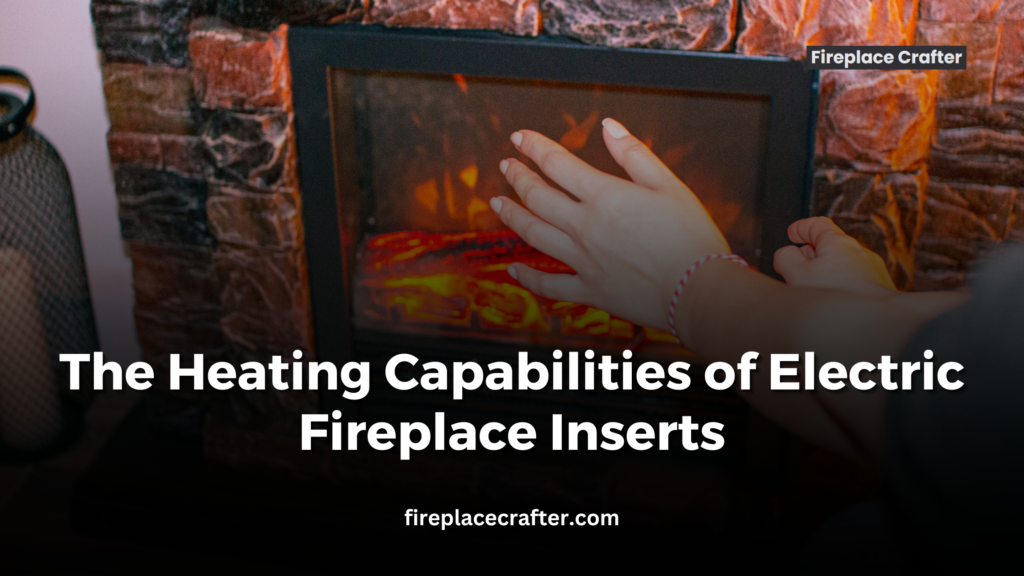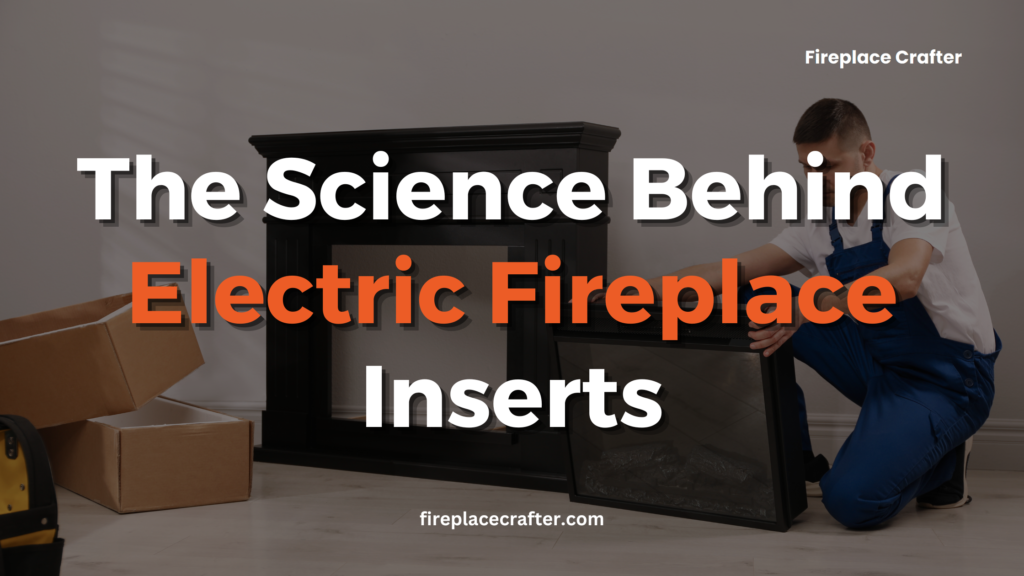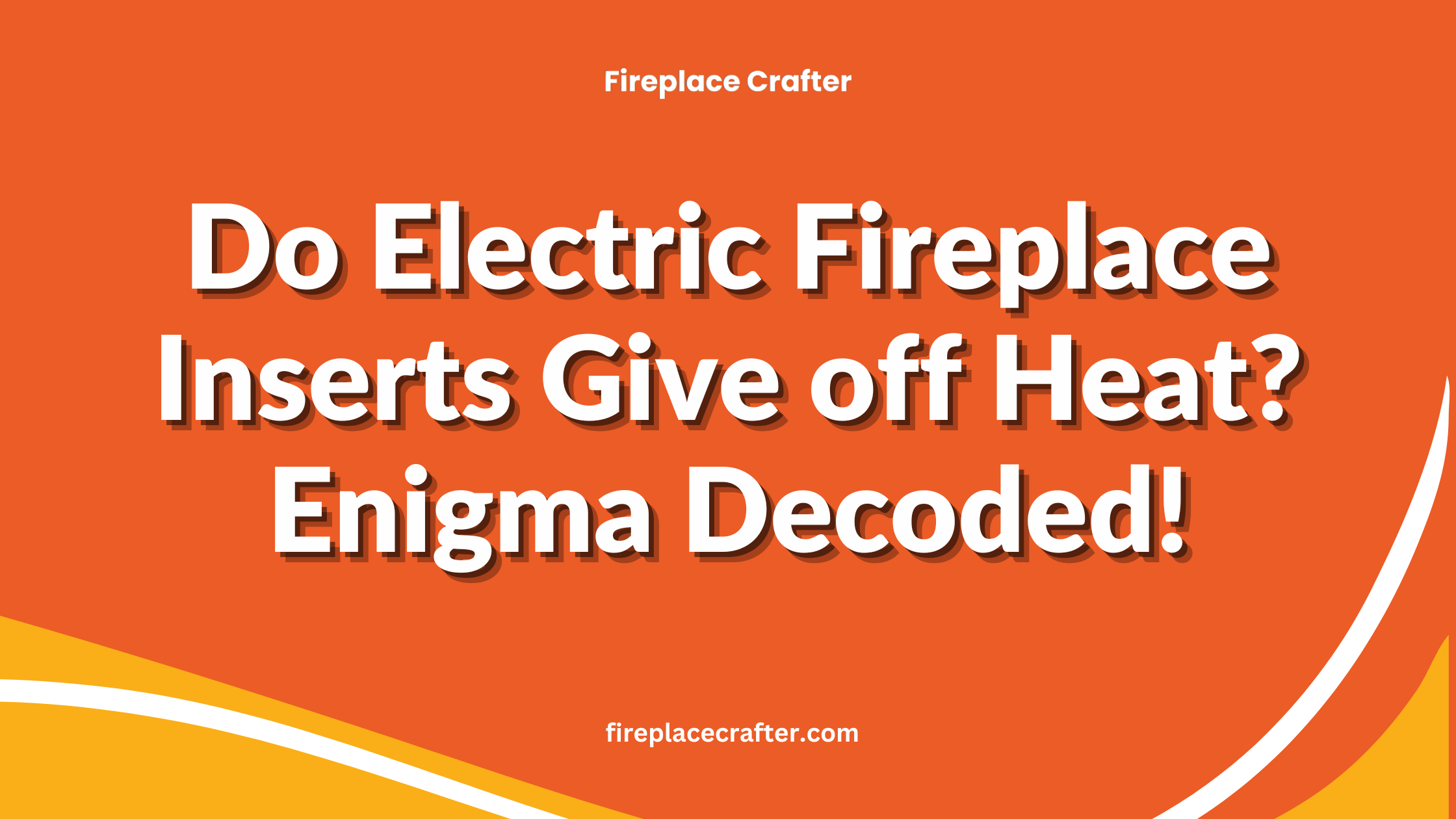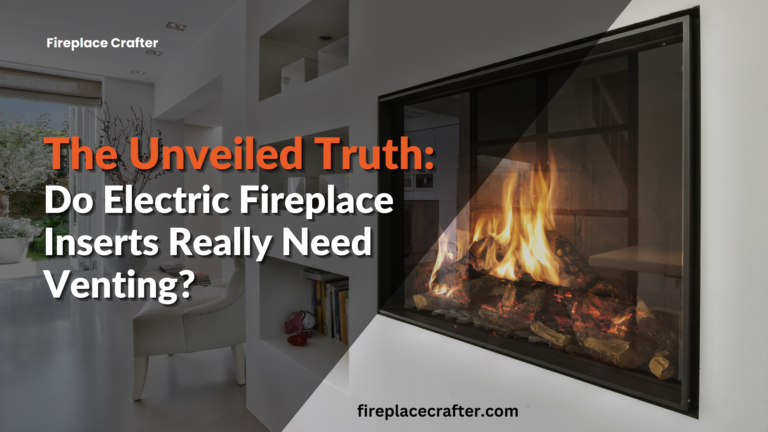Do Electric Fireplace Inserts Give off Heat? Enigma Decoded!
Discover if electric fireplace inserts give off heat in our comprehensive blog post. Learn about their heating efficiency and benefits.
Electric fireplace inserts indeed emit heat, employing BTUs (British Thermal Units) as a measure. While their radiant heat might not rival that of traditional fireplaces, they effectively generate warmth. These appliances have garnered popularity as a contemporary alternative, blending aesthetics with potential heat. Amid winter’s frost or cool summer nights, an electric fireplace insert creates a warm, inviting ambience minus the inconvenience of managing firewood and extensive cleanup.
Yet, the question lingers – do electric fireplace inserts genuinely warm your space, or is the perceived warmth simply visual? This piece delves into the workings of electric fireplace inserts, assessing if they serve more than just an artistic purpose. We invite you to engage in unravelling the truth about electric fireplace inserts.
Understanding Electric Fireplaces
Electric fireplace inserts are advanced heating systems that simulate the appearance and feel of a traditional fireplace while employing electric power to generate heat. These inserts are designed to fit into existing fireplaces or custom-built mantels, making them versatile for various settings
Historical Evolution of Electric Fireplaces
In the late 20th century, a noticeable shift occurred in the design of electric fireplaces, as aesthetics began to take precedence. This led to the introduction of features like faux wood logs and flickering flame effects. With the dawn of the 21st century and LED technology, electric fireplaces took another leap forward. The realistic flame effects and energy savings made possible by LEDs have only added to their appeal.
Today’s electric fireplace inserts marry functionality and aesthetics, offering adjustable thermostats, timers, and remote controls. Yet, one question remains: can these stylish appliances deliver the traditional fireplace warmth? This ongoing exploration enhances our understanding of the electric fireplace’s role in modern homes.
Types of Electric Fireplace Inserts
In our quest to understand the heating capacity of electric fireplace inserts, it is crucial to recognize the variety of inserts available. Each type offers a unique blend of features and capabilities that can impact their heating efficiency.

- Traditional Log Set Inserts
- Contemporary Linear Inserts
- Infrared Quartz Inserts
- Wall-Mounted Inserts
- Electric Fireplace Stoves
Comparison of Different Types
Selecting the ideal electric fireplace insert requires careful consideration of factors such as the desired heating capacity, budgetary constraints, and personal aesthetic preferences. Assessing the size of the space you intend to heat is crucial in determining the appropriate insert for your needs.
Considering your budget and specific design preferences will help you find an electric fireplace insert that meets both functional and aesthetic requirements.
Traditional Electric Fireplace Inserts
- Popular due to their inexpensiveness and ease of installation.
- Use a fan-forced heater to blow warm air into the room.
- Ideal for smaller rooms or spaces needing supplemental heating
- Can be installed without professional help.
- May not be as efficacious for larger spaces or as the main heat source.
Infrared Electric Fireplace Inserts
- More energy-efficient, suitable for heating larger areas
- Use infrared technology to generate heat, warming objects directly rather than the air.
- Provide more comfortable and consistent heat throughout the room.
- Quieter and generally last longer than fan-forced heaters.
- Higher price tag due to the added benefits of infrared technology.
LED Electric Fireplace Insert
- Top of the range in terms of visual appeal and energy efficiency
- Use LED lights to produce the most realistic flame effects.
- Excellent choice for those prioritizing aesthetics.
- Incredibly energy efficiency, using less electricity than both traditional and infrared models.
- Most expensive options on the market due to their many benefits.
Heating Capacity of Electric Fireplace Inserts
- Heating capacity varies widely depending on the specific model and its features.
- Effectiveness of heating ability is influenced by factors like wattage, room size, insulation, and how well the room retains heat.
- Can provide supplemental heat and, in some cases, be the primary heat source.
- Essential to thoroughly research and consider specific heating needs before making a decision.
Wall-Mounted Inserts
- Convenient and versatile, suitable for homes with limited floor space.
- Installation typically requires professional help due to wall-mounting.
- Can create a striking visual impact and add to the aesthetic appeal of a room.
- Heating capacity varies based on model, some are ideal for smaller rooms while others can heat larger areas.
- Tend to be more expensive due to their modern design and installation complexity.
- Some models offer unique features like color-changing flames and backlights for an enhanced visual effect.
The Heating Capabilities of Electric Fireplace Inserts
Considering whether electric fireplace inserts can genuinely warm up a space, it’s essential to delve into their heating capabilities. How do we measure their heat output, what factors influence their effectiveness, and how do they compare to traditional fireplaces?

Determining Heat Output
Like other heating devices, electric fireplace inserts have their heat output measured in British Thermal Units (BTUs).
Variables Influencing Heat Dispersion
- The room size: larger, open-plan spaces with high ceilings require more heating capacity.
- Quality of insulation: A well-insulated room retains heat more efficiently.
- Presence of windows and doors: Large windows and multiple doors may lead to heat loss.
- Location of the insert: Positioning the electric fireplace insert against an exterior wall may result in heat loss to the outside.
- For instance, a vast, open area with high ceilings and big windows will necessitate a higher heating capacity than a small, well-insulated room.
- The placement of the electric fireplace insert can significantly affect heat distribution. Some heat may escape outside if the insert is placed against an external wall.
Comparative Analysis: Electric Fireplaces Vs. Traditional Fireplaces
When comparing electric fireplace inserts with traditional fireplaces, it’s crucial to recognize their distinct capabilities:

Differences in Heating Mechanisms
- Traditional fireplaces generate heat by burning wood or gas, but much of this heat is lost through the chimney.
- Electric fireplace inserts produce heat using electricity, ensuring no heat is lost due to a lack of venting requirements.
Efficiency in Heating
- A high-quality electric fireplace insert can be more efficient than a traditional fireplace because it directly heats the room without any heat loss.
- The heat generated by a traditional fireplace can often feel more intense due to the radiant heat directly emitted from the flames and the heated surfaces of the fireplace.
Can an Electric Fireplace Insert Heat Your Space?
- The answer is a booming yes, but with caveats.
- The heating capacity depends on the type of insert, its BTU output, the room’s characteristics, and the insert’s location.
- Electric fireplace inserts offer a more efficient alternative to traditional fireplaces, although they may not deliver the same level of radiant heat.
The Science Behind Electric Fireplace Inserts
It is important to understand their science to fully comprehend how electric fireplace inserts work and their ability to heat your space. So, let’s dive into the mechanics of electric fireplaces and the process through which they generate heat.

The Mechanics of Electric Fireplaces
The operation of an electric fireplace insert involves two main and key components: the heating element and the visual display.
The visual display is often a series of LED lights that mimic the look of flames. These lights can be arranged in different patterns and often incorporate refracting lenses to create the three-dimensional illusion of a dancing fire. Some inserts also include a bed of faux logs or crystals that glow, enhancing the realism of the display.
The heating component of an electric fireplace insert operates independently of the visual display. This means you can now enjoy the ambiance of the ‘fire’ without generating heat, or vice versa. It uses a heating element, essentially a high-resistance wire that heats up as electric current passes through it.
How do Fireplaces Generate Heat?
Electric fireplace inserts operate similarly to any other electric heater when it comes to generating heat. They use the principle of electrical resistance. The energy is converted into heat when electricity passes through the high-resistance wire in the heating element.
Our comprehensive article, “How Much Heat Does an Electric Fireplace Insert Create?” delves into the mechanics and workings of electric fireplaces to shed light on their heat generation capabilities. We explore the factors contributing to their effectiveness in producing warmth and provide in-depth information on how electric fireplaces generate heat.
Limitations and Considerations
While electric fireplace inserts have advantages, it’s also crucial to acknowledge their limitations and the important considerations that come into operation when deciding whether they fit your heating needs.
Potential Heat Limitations
One key limitation of electric fireplace inserts is their heating capacity. While they can effectively heat small to medium-sized rooms, their reach may need to be higher in larger spaces. Even with their highest heat settings, they may need help to provide sufficient warmth for large or poorly insulated rooms.
Moreover, electric fireplace inserts generate convective heat, which heats the air and then circulates the room. This differs from the radiant heat generated by traditional wood or gas fireplaces, which directly warms objects and people in their path, often providing a more intense feeling of warmth.
Environmental Impacts
While electric fireplace inserts do not produce smoke or harmful fumes like traditional fireplaces, their environmental impact is tied to the source of their electricity.
Note: In our comprehensive article “Energy Efficiency and Environmental Impact” we thoroughly explore the environmental impact of electric fireplace inserts. We provide detailed information and insights on this topic, ensuring you completely understand its environmental implications.
Suitability for Large Spaces
As mentioned earlier, there may be better solutions than electric fireplace inserts for larger spaces. While some high-end models or infrared inserts can heat larger rooms more effectively, they are generally most efficient in spaces of around 400 square feet.
Therefore, if you want to heat a large room or a whole house, you might need to consider alternative heating solutions or use the electric fireplace insert in conjunction with other heating systems.
While electric fireplace inserts can indeed provide warmth, their effectiveness depends on several factors. Before making a purchase, consider the size and insulation of your space, the source of your electricity, and your heating expectations to ensure that an electric fireplace insert is the right solution for you.
Conclusion
Electric fireplace inserts give off heat while seamlessly merging the charm of a crackling fire with contemporary convenience. They emit warmth, eliminating the need for wood chopping or ash cleaning, their heating efficiency marked in BTUs, and determined by factors like insert type and room size. While their suitability may be questionable for larger spaces due to potential environmental impacts, they are a delightful choice for small to medium-sized areas, fostering a snug atmosphere. The warmth from an electric fireplace insert extends beyond physical heat, encapsulating ambiance and a cozy environment that contributes its own unique warmth to our homes.







